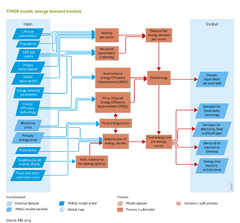Energy demand: Difference between revisions
Jump to navigation
Jump to search
Oostenrijr (talk | contribs) No edit summary |
Oostenrijr (talk | contribs) No edit summary |
||
| Line 15: | Line 15: | ||
These factors are implemented in different ways in the various sectors. In some sectors, a detailed end-use service-oriented modelling approach is used while in other sectors, the description is more generic and aggregate. Energy prices link the demand module with other parts of the energy model, as they respond dynamically to changes in demand, supply and conversion. | These factors are implemented in different ways in the various sectors. In some sectors, a detailed end-use service-oriented modelling approach is used while in other sectors, the description is more generic and aggregate. Energy prices link the demand module with other parts of the energy model, as they respond dynamically to changes in demand, supply and conversion. | ||
<div class=" | <div class="timer3.0"> | ||
dit is gewijzigde tekst voor versie 3.1 | dit is gewijzigde tekst voor versie 3.1 | ||
</div> | </div> | ||
Revision as of 16:38, 14 October 2016
| Component is implemented in: |
|
| Related IMAGE components |
| Projects/Applications |
| Key publications |
Key policy issues
- How will energy demand evolve particularly in emerging and medium- and low-income economies?
- What is the mix of end-use energy carriers to meet future energy demand?
- How can energy efficiency contribute to reducing the growth rate of energy demand and mitigate pressures on the global environment?
